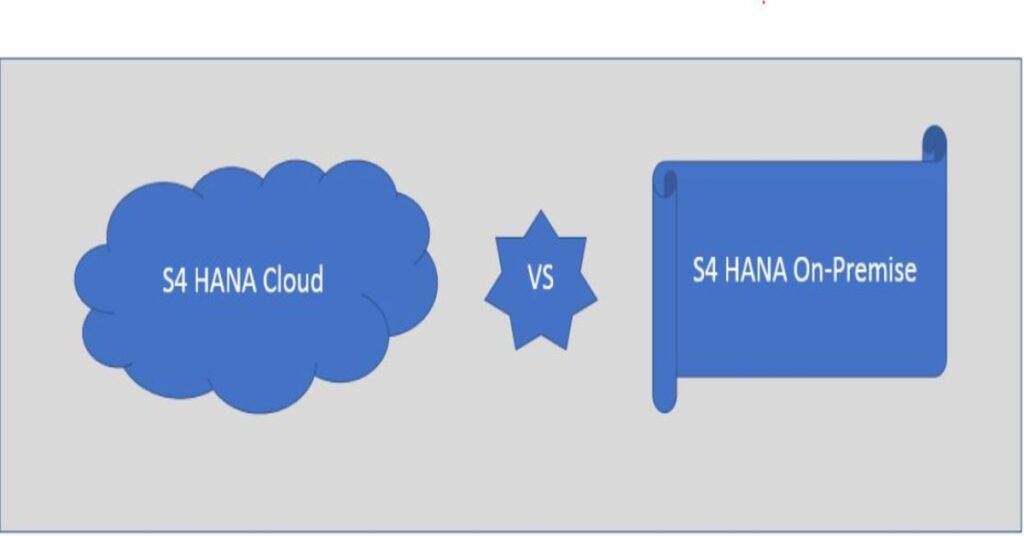Every business aims to make its processes more efficient, and implementing a modern ERP system is a big step toward achieving that goal. One of the top players in the ERP market an innovative system designed to automate and streamline critical operations, from finance to supply chains.

SAP S/4HANA gives businesses the flexibility to choose how they deploy the system: On-Premise, Cloud, or hybrid. On-premise is installed on the company’s own servers, the cloud is hosted online, and the hybrid model combines both approaches. Each option comes with its own set of benefits, challenges, and unique features, depending on your company’s goals, resources, and overall strategy.
The question is how can your business prepare for SAP S/4HANA implementation and which deployment approach should you choose: on-premise, cloud, or hybrid? Let’s find out which edition will meet all your business needs.
1. Understanding SAP On-Premises
SAP On-Premises means the software is installed and hosted on your company’s own servers. You are responsible for buying the hardware, installing SAP, managing updates, ensuring security, and handling maintenance.
- Ownership – You fully own the infrastructure and software licenses.
- Customization – High flexibility to tailor the system to your business processes.
- Control – You manage data storage, backups, and compliance.
Example:
A large manufacturing company with strict security regulations may choose SAP S/4HANA On-Premises to keep sensitive production and supplier data within its own IT environment.
2. Understanding SAP Cloud

SAP Cloud is a subscription-based service where SAP is hosted on cloud servers (public, private, or hybrid) and accessed via the internet. The service provider handles installation, upgrades, backups, and security.
- Scalability – Easily add more users or storage when needed.
- Lower upfront cost – No expensive hardware investment.
- Automatic updates – Always on the latest version without manual effort.
Example:
A mid-sized e-commerce business may opt for SAP S/4HANA Cloud to quickly set up operations without heavy IT investment and benefit from rapid scalability during seasonal demand spikes.
3. Key Differences Between SAP On-Premises and SAP Cloud
Here’s a side-by-side comparison table for quick reference:
| Feature | SAP On-Premises | SAP Cloud |
|---|
| Deployment | Installed on company-owned servers | Hosted on cloud provider’s servers |
| Ownership | Full ownership of software & hardware | Subscription-based access |
| Customization | Highly customizable | Limited customization |
| Cost Model | High upfront cost + maintenance fees | Monthly/annual subscription |
| Scalability | Requires new hardware for expansion | Instantly scalable |
| Upgrades | Manual, planned by IT team | Automatic by provider |
| Data Control | Fully in your control | Managed by provider |
| Security | Managed internally | Managed by provider, with shared responsibility |
| Access | Usually internal network | Accessible from anywhere with internet |
| Speed of Deployment | Longer setup time | Faster implementation |
4. Deployment and Setup Time
One of the most obvious differences is how quickly you can start using the system.
- On-Premises – Requires purchasing hardware, installing the system, configuring the network, and training the team. This could take several months.
- Cloud – Can be ready in weeks or even days, depending on the complexity.
Real-world scenario:
A retail chain launching new stores in multiple cities might prefer SAP Cloud to avoid delays, while a government agency with strict data regulations might choose On-Premises despite the longer setup time.
5. Cost Considerations
On-Premises requires large upfront investment in servers, software licenses, and IT staff. Over time, you also pay for maintenance, power, cooling, and upgrades.
Cloud follows a pay-as-you-go model, which spreads costs over time and avoids capital expenditure. However, long-term subscription fees can add up.
Tip: Always calculate the Total Cost of Ownership (TCO) over 5–10 years before deciding.
6. Customization and Flexibility
- On-Premises – Full flexibility to modify code, integrate with third-party tools, and adapt to unique workflows.
- Cloud – Limited customization to ensure stability and compatibility with automatic updates.
Example:
A pharmaceutical company with highly specialized manufacturing processes might require On-Premises for deep customization.
7. Security and Data Control
- On-Premises – Data is stored internally, giving you full control. You manage firewalls, backups, and disaster recovery.
- Cloud – Data is stored on the provider’s servers, with shared responsibility for security. Providers like SAP offer world-class encryption and compliance certifications.
Note: In industries like banking or defense, data sovereignty laws may require On-Premises solutions.
8. Upgrades and Maintenance
On-Premises – You control when and how to upgrade, but this requires planning and downtime.
Cloud – Upgrades are automatic and continuous, ensuring access to the latest features without disruption.
9. Scalability and Performance

- On-Premises – Scaling up means buying more hardware, which takes time and investment.
- Cloud – Instantly scalable, allowing businesses to respond quickly to growth or seasonal demand.
Example:
An online retailer can handle sudden Black Friday traffic spikes easily with SAP Cloud, while an On-Premises setup might struggle without prior expansion.
10. Real-World Case Studies
Case Study 1 – On-Premises
A global automotive company chose SAP S/4HANA On-Premises to integrate manufacturing plants worldwide, allowing deep customization and meeting strict security standards.
Case Study 2 – Cloud
A fast-growing SaaS startup implemented SAP S/4HANA Cloud to streamline finance, HR, and customer data. The cloud setup enabled rapid scaling without building an IT department from scratch.
10. Which One Should You Choose?
Choose SAP On-Premises if:
- You require maximum customization
- You have strict data security regulations
- You have a large IT team to manage the system
- You want full ownership of your infrastructure
Choose SAP Cloud if:
- You want quick deployment
- You prefer lower upfront costs
- You need scalability for growth
- You want to reduce IT maintenance work
12. Conclusion
The difference between SAP On-Premises and SAP Cloud comes down to control, cost, flexibility, and speed.
- On-Premises offers control, deep customization, and ownership, but with higher costs and slower setup.
- Cloud offers speed, scalability, and reduced maintenance, but with less customization.
Ultimately, your choice should align with your business goals, budget, compliance requirements, and IT capabilities.
If done right, either deployment model can deliver the full power of SAP to transform your business operations and drive long-term success.
FAQ
Which is better: SAP On-Premises or SAP Cloud?
Answer: There’s no universal “better” option — it depends on your business needs. Choose On-Premises if you need full control, deep customization, and meet strict data regulations. Choose Cloud if you want quick deployment, scalability, and lower upfront costs.
Is SAP Cloud cheaper than SAP On-Premises?
Answer: In the short term, SAP Cloud is usually cheaper because it avoids large upfront costs. However, over many years, subscription fees can add up, so a Total Cost of Ownership (TCO) comparison is recommended.
Can SAP Cloud be customized like SAP On-Premises?
Answer: SAP Cloud allows some customization, but it’s more limited compared to On-Premises. The cloud model prioritizes stability, compatibility, and regular updates, which means heavy custom coding is not always possible.
